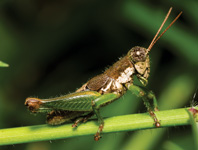Abstract
Three new species of the genus Coecobrya are described from caves in the Thai Peninsula for the first time: C. cavicta sp. nov. and C. polychaeta sp. nov. from Satun Province, and C. chumphonensis sp. nov. from Chumphon Province. These species differ in antennal length, clypeal chaetae, labial palp, sublobal chaetae of maxillary outer lobe, labial and postlabial chaetae, claw, ventral tube, manubrial plaque, and dorsal cephalic and tergal chaetotaxy. They are similar to C. annulata Zhang, Bedos & Deharveng, 2016 but differ from the latter in the combination of antennal length, claw and dorsal chaetotaxy. DNA barcoding COI sequences are provided for two species and three populations and key to the Thai species is also given. One population, which exhibits a great genetic distance (0.219–0.239) and minor but stable morphological differences from C. polychaeta sp. nov., cannot be accepted as a full species as the evidence is insufficient.
References
Carstens, B.C., Pelletier, T.A., Reid, N.M. & Satler, J.D. (2013) How to fail at species delimitation. Molecular Ecology, 22, 4369–4383.
https://doi.org/10.1111/mec.12413Chen, J.X. & Christiansen, K.A. (1993) The genus Sinella with special reference to Sinella s. s. (Collembola: Entomobryidae) of China. Oriental Insects, 27, 1–54.
https://doi.org/10.1080/00305316.1993.10432236Christiansen, K. (1961) Convergence and parallelism in cave Entomobryinae. Evolution, 15, 288–301.
https://doi.org/10.2307/2406229Christiansen, K. & Bellinger, P. (1992) Insects of Hawaii. Volume. 15, Collembola. University of Hawaii Press, Honolulu, 445 pp.
Cipola, N.G. & Bellini, B.C. (2016) A new cave species of Coecobrya Yosii (Collembola, Entomobryidae, Entomobryinae) from South Africa, with an identification key to the genus. Zootaxa, 4200 (3), 351–366.
https://doi.org/10.11646/zootaxa.4200.3.1Deharveng, L. (1990) Fauna of Thai caves. II. New Entomobryiodea Collembola from Chiang Dao cave, Thailand. Occasional Papers of the Bernice P. Bishop Museum, 30, 279–287.
Folmer, O., Black, M., Hoeh, W., Lutz, R. & Vrijenhoek, R. (1994) DNA primers for amplification of mitochondrial cytochrome c oxidase subunit I from diverse metazoan invertebrates. Molecular Marine Biology and Biotechnology, 3, 294–299.
Jantarit, S., Bedos, A. & Deharveng, L. (2016) An annotated checklist of the Collembola fauna of Thailand. Zootaxa, 4169 (2), 301–360.
https://doi.org/10.11646/zootaxa.4169.2.4Katoh, K. & Standley, D.M. (2013) MAFFT multiple sequence alignment software version 7: improvements in performance and usability. Molecular Biology and Evolution, 30, 772–780.
https://doi.org/10.1093/molbev/mst010Katz, A.D., Giordano, R. & Soto-Adames, F.N. (2015) Operational criteria for cryptic species delimitation when evidence is limited, as exemplified by North American Entomobrya (Collembola: Entomobryidae). Zoological Journal of the Linnean Society, 173, 818–840.
https://doi.org/10.1111/zoj.12220Kimura, M. (1980) A simple method for estimating evolutionary rates of base substitutions through comparative studies of nucleotide sequences. Journal of Molecular Evolution, 16, 111–120.
https://doi.org/10.1007/BF01731581Porco, D., Skarżyński, D., Decaëns, T., Hebert, P.D.N. & Deharveng, L. (2014) Barcoding the Collembola of Churchill: a molecular taxonomic reassessment of species diversity in a sub-Arctic area. Molecular Ecology Resources, 14, 249–261.
https://doi.org/10.1111/1755-0998.12172
Schäffer, C. (1896) Die Collembola der Umgebung von Hamburg und benachbarter Gebiete. Mitteilungen aus dem Naturhistorischen Museum in Hamburg, 13, 149–216.
Schneider, C., Porco, D. & Deharveng, L. (2016) Two new Megalothorax species of the minimus group (Collembola, Neelidae). Zookeys, 554, 37–68.
https://doi.org/10.3897/zookeys.554.6069Szeptycki, A. (1979) Chaetotaxy of the Entomobryidae and its phylogenetical significance. Morpho-systematic studies on Collembola. IV. Polska Akademia Nauk, Zaklad Zoologii Systematycznej i Doświadczalnej, Państwowe Wydawnictwo Naukowe, Warszawa, Kraków, 219 pp.
Tamura, K., Peterson, D., Peterson, N., Stecher, G., Nei, M. & Kumar, S. (2011) MEGA5: Molecular evolutionary genetics analysis using maximum likelihood, evolutionary distance, and maximum parsimony methods. Molecular Biology and Evolution, 28, 2731–2739.
https://doi.org/10.1093/molbev/msr121Yosii, R. (1956) Höhlencollembola Japans II. Japanese Journal of Zoology, 11, 609–627.
Zhang, F., Bedos, A. & Deharveng, L. (2016) Cave-dwelling Coecobrya from southern China with a survey of clypeal chaetae in Entomobryoidea (Collembola). European Journal of Taxonomy, 226, 1–21.
https://doi.org/10.5852/ejt.2016.226Zhang, F. & Deharveng, L. (2015) Systematic revision of Entomobryidae (Collembola) by integrating molecular and new morphological evidence. Zoologica Scripta, 44, 298–311.
https://doi.org/10.1111/zsc.12100Zhang, F., Deharveng, L. & Chen, J.X. (2009) New species and rediagnosis of Coecobrya (Collembola: Entomobryidae), with a key to the species of the genus. Journal of Natural History, 43, 2597–2615.
https://doi.org/10.1080/00222930903243970Zhang, F., Yu, D.Y., Luo, Y.Z., Ho, S.Y.W., Wang, B.X. & Zhu, C.D. (2014) Cryptic diversity, diversification and vicariance in two species complexes of Tomocerus (Collembola, Tomoceridae) from China. Zoologica Scripta, 43, 393–404.
https://doi.org/10.1111/zsc.12056Zhang, F., Yu, D.Y. & Xu, G.L. (2011) Transformational homology of the tergal setae during postembryonic development in the Sinella-Coecobrya group (Collembola: Entomobryidae). Contributions to Zoology, 80, 213–230.

